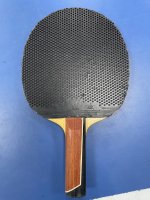One of my teammates has this playingstyle with nearly the same equipment as the indian pro Batra.
Usually these players can block everything with their lp bh but not so much with their fh.
The main issue here is that those players tend to keep you on your bh. Learning to step deeper into your bh side and attack with your fh down the line is a huge advantage. If you are slow on your legs you can gain that advantage faster by learning to flick right into their fh side.
Another general tip here is, that you should attack hard. Dont weak loop around and hope for the best. Because every spinny loop will result in horror for yourself. Just play long underspin or no spin balls (or serves) into the lp and topspin the shit out of them.
If they use their fh to attack too you can either use that to get "normal" rallyes, or on case you cant block attacks that well you have tight schedule, because you should get that attack as fast as you can.
The moment they push with their lp a nospin or underspin ball you have to attack. Another push from you would result in high arced ball, that your opponent will attack.
I posted that Video before but here are some bh examples that work quite well against this certain player:
You can see that i mostly try to hit quite hard shots so he cant block them so easily. I either flick his serves and try to place them in his awkward middle or into his fh as deep as i am able to.
If you are interested i could try to cut the full match propperly and upload it.
Maybe i can come up with a newer match even today.










